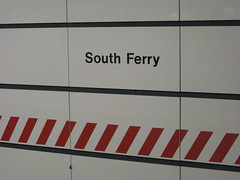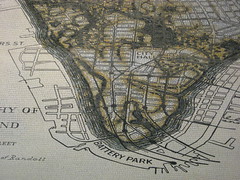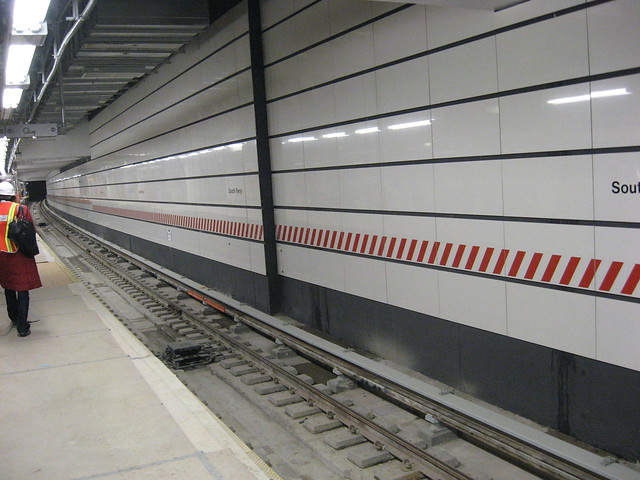Sometime next month, the MTA will, for the first time in twenty years, open a new subway station in New York City. The new terminal at South Ferry — the first post-9/11 redevelopment project to open in Lower Manhattan — features a fully ADA-compliant two-track station with wide platforms and state-of-the-art engineering. It will offer up a connection to the R and W trains at Whitehall St. and will serve as the station of the future, a prototype of sorts for the three stations planned along Second Ave., and it looks great.
Yesterday, Michael Horodniceanu, the president of MTA Capital Construction, led a group of reporters and photographers on a tour of the not-yet-completed facility, and I was lucky enough to get an invite. Let’s take a tour of the new station. (All links go to my flickr photo set of the tour. The slideshow is embedded below.)
 First, let’s set the scene. The current station at South Ferry is more than a bit decrepit. It’s a tiny station with room for five cars, and since it’s on a steep curve, it employs movable platforms. Somehow, it also serves six million passengers a year bound for Staten Island, Lady Liberty and all points in between. When the federal government offered up a large grant to redevelopment Lower Manhattan, the South Ferry stop along with the tortured Fulton St. hub were chosen for funding.
First, let’s set the scene. The current station at South Ferry is more than a bit decrepit. It’s a tiny station with room for five cars, and since it’s on a steep curve, it employs movable platforms. Somehow, it also serves six million passengers a year bound for Staten Island, Lady Liberty and all points in between. When the federal government offered up a large grant to redevelopment Lower Manhattan, the South Ferry stop along with the tortured Fulton St. hub were chosen for funding.
The new station, when it opens next month, will carry with it a $527 million price tag, including $420 million from the feds, approximately $107 from the MTA’s coffers and the remainder from the city for the plaza that will one day surround the entrance.
So what can you get for $527 million these days? Well, for starters, we get 1800 feet of total construction. Of that, 1200 of those feet are a part of a brand new tunnel with the remainder serving as the station.
Instead of just one track, we now have two ten-car tracks. The station will serve as a bona fide terminal. As such, according to the MTA, the potential capacity along the 1 line will increase from around 17 trains an hour to up to 24, and the easing of the Lower Manhattan bottleneck could shave six minutes off of a trip from 242nd St. to South Ferry. The station is also equipped with signals ready for computer-based train control, if and when the MTA gets that program off the drawing board and into the tunnels.
But beyond the technicalities of the track, the station itself is chock full of modern amenities. It features various escalators including some of those new smart escalators that slow down and speed up as passenger demand increases. The platform itself is very wide. While my pictures don’t quite capture how wide they are, this double-sided staircase leads down to the tracks with room on both sides.
More impressive is the cooling technology in place. The new South Ferry terminal features tempered air. As best as I can tell, the system is an underground air conditioned that kept the station positively balmy on a cold December day and will, according to Horodniceanu, ensure that the station “won’t be as hot in the summer” as some of the others. Air conditioned subways! Who knew?
The mezzanine level is by far the nicest in the station. While it does feature the ubiquitious security cameras, it is an expansive and gleaming entry way to the station. Most noticeable is the artwork. The MTA Arts for Transit program spent $1 million on station decorations, and according to Sandra Bloodworth, the director of Arts for Transit, did so to tie the station into its surroundings. “The idea,” she said, “was to bring the park into the station.”
Past the turnstiles, the station features glass panels depicting trees, and outside, the security gates are beautifully designed to evoke the park instead of the MTA’s usually jail-like appearance.
 The jewel of the station is a mosaic map of Manhattan. Designed by the Starn Twins, the map is a 20-foot wide view of Manhattan from the Battery north. The first layer is a topographic map from 1640 and overlaid on that is a modern view of the city complete with the subway system. I snapped a detail of the map’s depiction of Lower Mahattan, and you can read more about the Starn brothers’ vision for the station at their website.
The jewel of the station is a mosaic map of Manhattan. Designed by the Starn Twins, the map is a 20-foot wide view of Manhattan from the Battery north. The first layer is a topographic map from 1640 and overlaid on that is a modern view of the city complete with the subway system. I snapped a detail of the map’s depiction of Lower Mahattan, and you can read more about the Starn brothers’ vision for the station at their website.
Beyond that, the station also features the 350-year-old Battery wall that held up construction when workers came across it a few years ago. When completed, it will connect to the BMT at Whitehall St. and feature a canopy entrance evocative of the DC Metro. Sadly, I doubt that the turnstiles will remain without arms for much longer.
The station looks great, and while it looked very much like a work in progress, Horodniceanu says it will open in January. Considering the engineering work that went into it — the station is built underneath the current South Ferry loop and the East Side IRT’s Joralemon St. Tunnel — it will stand as an impressive accomplishment in the painfully slow redevelopment of Lower Manhattan.


 While I study for my 1L law school exams, I’ve recruited a guest post or two for the next few weeks. Today, Chris Carrera, better know as the
While I study for my 1L law school exams, I’ve recruited a guest post or two for the next few weeks. Today, Chris Carrera, better know as the 

 Let’s talk New York State drivers licenses for a bit. They have become quite the hot topic on the transit front lately.
Let’s talk New York State drivers licenses for a bit. They have become quite the hot topic on the transit front lately.
 Now that we’ve all had a weekend to digest
Now that we’ve all had a weekend to digest 











